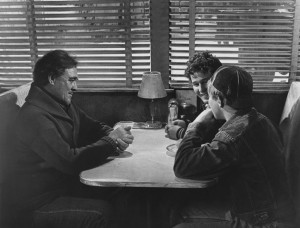Review by Trylon rural diegeticist Ben Schmidt
There’s a moment in The Last Picture Show where a young man named Sonny hops into his old, busted-up truck and drives it out of town. It’s late at night. And as Sonny rolls down Main Street, he looks through the windows of the decaying buildings he passes, the pool hall, the diner, the movie theater…there isn’t much else to see. We get the sense he’s decided to leave what little there is here behind.
But at the very edge of town he stops. Leaving his truck idling in the middle of the road, he hops out and sits against the driver’s side door. From here, the sparse lights of the small town of Anarene shimmer, floating in the vast, dark emptiness of North Texas. From what we’ve seen so far, the town he’s grown up in holds little promise. But the world beyond may hold even less. So back he turns, for while this withering town might feel like a prison, it’s at least one familiar to him.
Despite this largely being Sonny’s story, it’s Anarene itself that serves as The Last Picture Show’s tragic hero. The film opens on one of its empty streets, and a slow pan allows us to take in the regret and emptiness that threatens to swallow everyone who calls this place home.
It’s here, by way of Sonny, we meet Sam the Lion, who tends the pool hall where the young men play billiards and the elders play dominos. Weathered and wealthy, Sam owns the few small businesses that keep this small town from being carried off by the wind.
This pool hall serves as a second home to Sonny, a home shared with his best friend, Duane. Together they co-captain the high school football team. Enduring a less-than-stellar season, the two have become a convenient focus for much of the townsfolk’s frustrations.
Sonny soon crosses paths with Ruth, the long-suffering wife of the football team’s coach. Perhaps Ruth sees what we see in Sonny, a depth and kindness that’s surprising for a man so young. Or just a man at all. Meanwhile, Duane just generally suffers at the hands of Jacy, Anarene’s most popular girl, who always seems to be eyeing something better.
But damn, see here’s where I fear an amateur, pithy synopsis can’t rightly sell a film like The Last Picture Show. Because what the poor souls of Anarene do or don’t do here is moot. It’s how they react to what’s being done to them– their lusting, longing, raging, and settling–that serves to captivate us.
Though released in 1971, director Peter Bogdanovich chose to shoot the film in stark black and white, a choice encouraged by Orson Welles. Brilliant, as color would have contended with the raw emotion on display here. Often striking, the cinematography enhances the sense that the world of these characters has all but been spent. Though honestly, the more brilliant (and much more subtle) decision was the extensive use of diegetic music (captured from real radios and record players on location) throughout the film. Often (or perhaps only) featuring songs by Hank Williams, it makes for a haunting soundtrack, one that keeps us uncomfortably tethered to the ceaseless discontent, regret, and agonizing heartbreak on display in The Last Picture Show.
It’s a wonderful film. — Ben Schmidt
THE LAST PICTURE SHOW screens Friday and Saturday, July 31 and August 1 at 7:00 and 9:15, and Sunday, August 2 at 5:00 and 7:15. Advance tickets are $8.00, and you can purchase them here.

